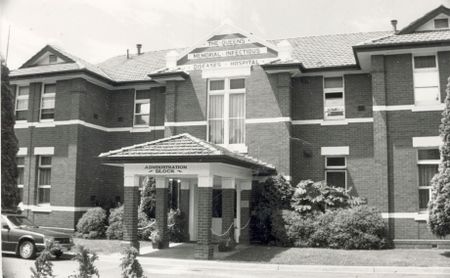Fairfield Infectious Diseases Hospital
1904 establishments in Australia1996 disestablishments in AustraliaBuildings and structures in the City of YarraDefunct hospitals in Victoria (Australia)HIV/AIDS memorials ... and 6 more
Heritage-listed buildings in MelbourneHospital buildings completed in 1901Hospitals disestablished in 1996Hospitals established in 1904Hospitals in MelbourneUse Australian English from March 2018

Fairfield Infectious Diseases Hospital, originally known as Queens Memorial Infectious Diseases Hospital, operated from 1904 to its closure in 1996. Perched high on the banks of the Yarra River at Yarra Bend in the inner Melbourne suburb of Fairfield, it developed an international reputation for the research and treatment of infectious diseases. When it closed, it was the last specific infectious diseases hospital in Australia. Initially the hospital was devoted to the treatment of patients with fevers. Diseases treated included typhoid, diphtheria, cholera, smallpox, poliomyelitis and scarlet fever, and in its final years, HIV/AIDS became very prominent.
Excerpt from the Wikipedia article Fairfield Infectious Diseases Hospital (License: CC BY-SA 3.0, Authors, Images).Fairfield Infectious Diseases Hospital
Yarra Bend Road, Melbourne Fairfield
Geographical coordinates (GPS) Address Nearby Places Show on map
Geographical coordinates (GPS)
| Latitude | Longitude |
|---|---|
| N -37.788013888889 ° | E 145.01129166667 ° |
Address
Melbourne Polytechnic (Fairfield Campus)
Yarra Bend Road
3078 Melbourne, Fairfield
Victoria, Australia
Open on Google Maps






